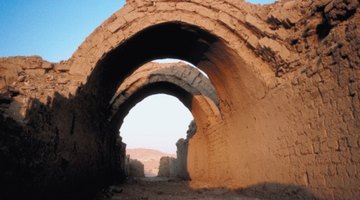Although most people know where the ancient pharaohs expected to spend their afterlife, less is known about where the pharaohs spent their actual lives. Through archaeological evidence discovered at sites such as Malkata, the royal complex of Amenhotep III, a picture of pharaonic palaces emerges. Situated within vast complexes, the homes and palaces of the pharaohs were often cities within themselves.
Royal Complexes
Pharaonic homes were commonly in the center of vast capital complexes, surrounded by needed resources, servants and temples. These complexes were often self-sufficient entities, relying little on outside materials, such as food and water. Different rooms and buildings in the complex served different functions, from audience halls to gardens and kitchens. Royal apartments were another part of these complexes, with the pharaoh, queen and harem housed separately. The abodes of non-royals were much smaller in scale. The poorest commoners lived in one room houses with grass or animal hair mats on the floor for sitting and sleeping. Mats also covered doors and windows to keep out dust and flies.
Building Materials

Due to the scarcity of wood, many homes utilized stone and mud brick. Stone, such as limestone and sandstone, was common only in the homes of the royal and noble Egyptians because of the expense involved in procuring it. Commoners assigned young children the task of mixing mud and clay for sun baked bricks. And although mud bricks were primarily for the construction of houses for the lower classes, there is evidence of mud brick used in palaces and royal apartments. Those found at the ruins of Malakata bear the cartouche of both Amenhotep III and his chief queen, Tiye.
Flat Roofs
Flat roofs were a common part of all ancient Egyptian homes, due to the fact that accumulated rainfall was not a concern in the region. The use of the flat roof not only provided shade from the sun, but was an easier method of construction. Many noble or royal homes used these roofs as patios, with elegant staircases leading up from the ground floor. Commoners used ladders or ramps to access their flat roof. Ancient Egyptians used these roof patios for lounging, eating or even sleeping on the hottest summer nights.
Ornate Decoration
A key distinction between royal and common homes was decoration and furnishing. The floors of royal apartments consisted of ceramic tiles while the walls featured painted murals. Much like royal tombs, painted scenes depicted the accomplishments of the pharaoh as well as his devotion to the gods. Fine furniture, woven reed mats for covering windows, and oil lamps were also common in noble homes. Cot-like benches used by nobles were generally wood stamped with gold leaf, with a woven, thatched center.
Related Articles
References
Writer Bio
Jennifer Hayes began writing professionally in 2010. Previously published online, Hayes has written a series of crafting tutorials with an emphasis on green crafting and creativity on a budget. She attended Southern Methodist University in Dallas, Texas, where she studied English and art.











